Income and wealth inequality refers to the unequal distribution of resources and income across individuals or groups within an economy. It stems from factors like education, discrimination, technological advancements, and government policies. Understanding this topic is crucial in microeconomics, as it affects economic efficiency, market outcomes, and the balance between equity and social welfare.
Learning Objectives
In studying “Income and Wealth Inequality” for AP Microeconomics, you should learn to understand the factors contributing to disparities in income and wealth distribution, including education, labor markets, and government policies. Analyze the economic and social consequences of inequality, such as reduced economic mobility and market inefficiencies. Evaluate how governments and institutions use policies like taxation, social programs, and labor regulations to address inequality and promote equitable growth. Additionally, explore theoretical perspectives on inequality and examine real-world examples to understand its effects on economies and societies.
1. Causes of Inequality
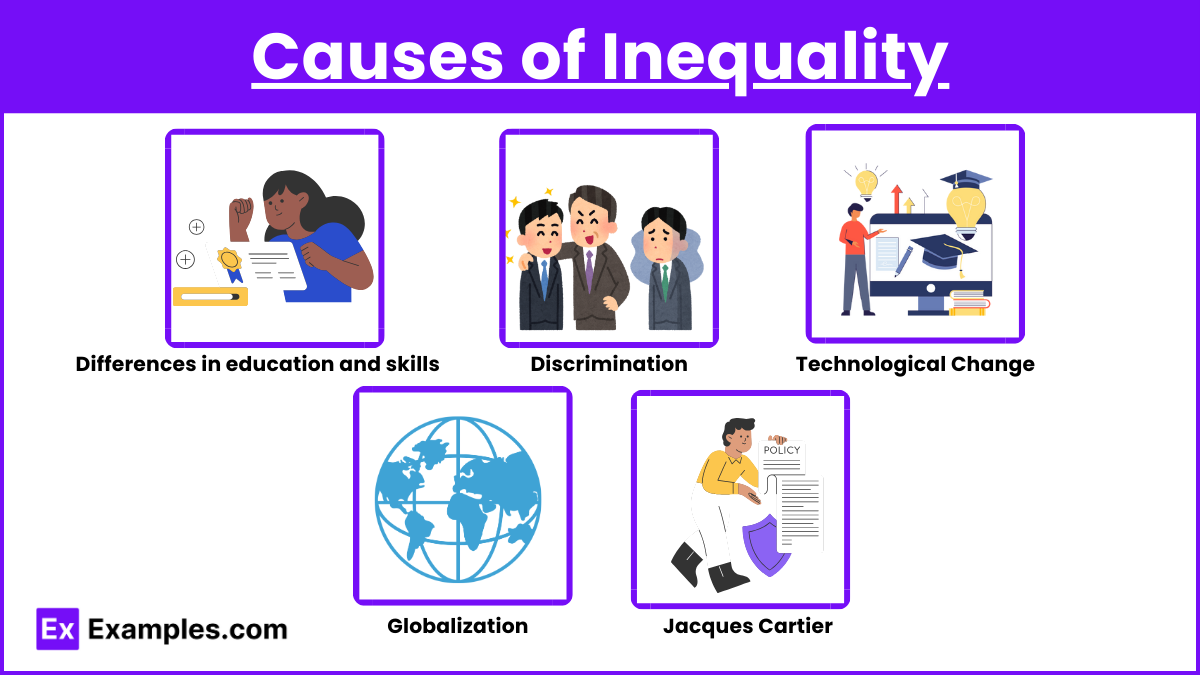
- Differences in education and skills: Higher-skilled workers typically earn more due to greater productivity. Education access can be uneven, contributing to inequality.
- Discrimination: Factors such as race, gender, and ethnicity may result in unequal opportunities, affecting income distribution.
- Technological Change: Technological advancements often benefit skilled workers, while unskilled workers may see stagnant wages or unemployment, increasing inequality.
- Globalization: International trade can lead to wage disparity, with workers in certain industries or countries earning more due to comparative advantages.
- Government Policy: Taxes, welfare systems, and labor market regulations directly influence the distribution of income. Policies such as progressive taxation reduce inequality, while regressive taxes may exacerbate it.
2. Measuring Inequality
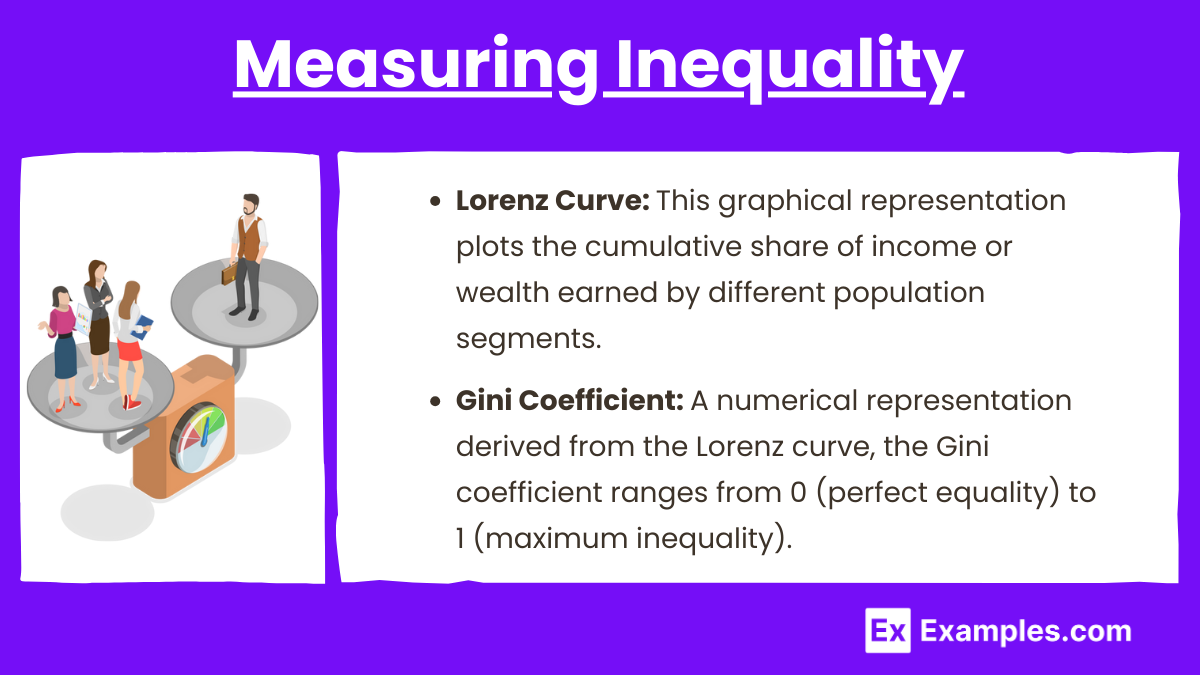
- Lorenz Curve: This graphical representation plots the cumulative share of income or wealth earned by different population segments. The closer the Lorenz curve is to the diagonal (perfect equality line), the more equal the distribution.
- Gini Coefficient: A numerical representation derived from the Lorenz curve, the Gini coefficient ranges from 0 (perfect equality) to 1 (maximum inequality). It’s widely used to measure inequality across different countries and regions.
3. Economic Implications
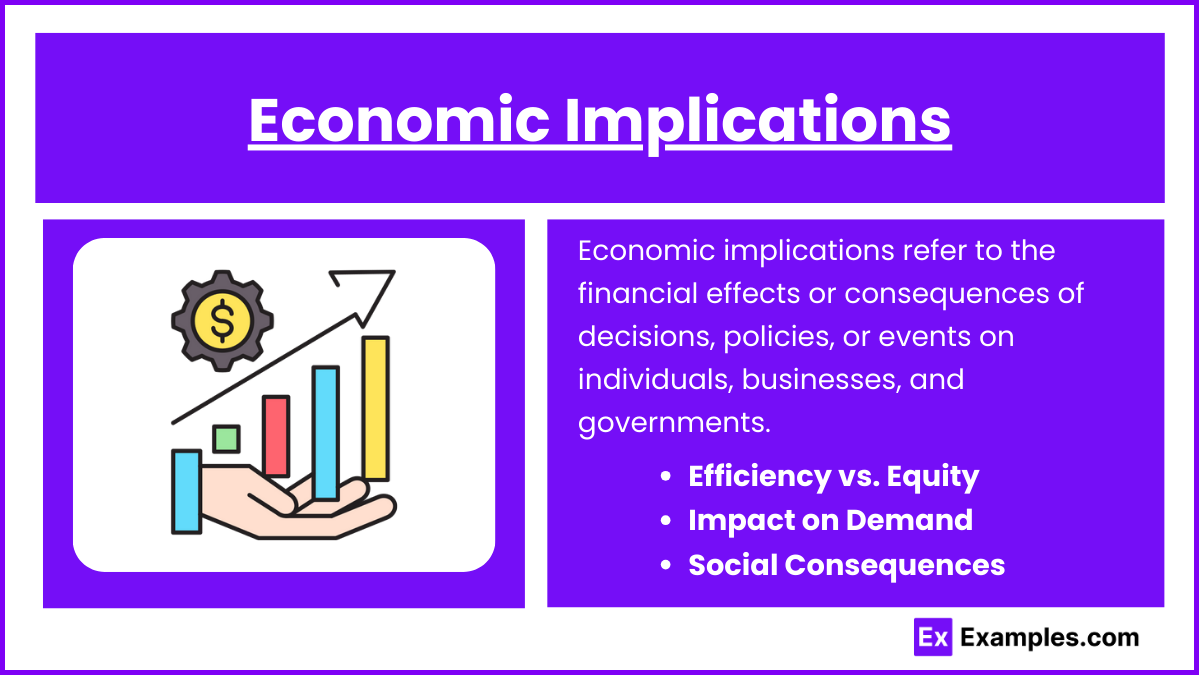
Economic implications refer to the financial effects or consequences of decisions, policies, or events on individuals, businesses, and governments. These impacts can include changes in employment, income, investment, trade, and overall economic growth, influencing future economic stability and development.
- Efficiency vs. Equity: High inequality can lead to inefficiency, as lower-income individuals may lack the resources to invest in education or start businesses. Conversely, redistributing income may reduce the incentive to work or invest, potentially harming economic efficiency.
- Impact on Demand: High levels of income inequality can reduce aggregate demand since lower-income households tend to have a higher marginal propensity to consume. This can lead to slower economic growth.
- Social Consequences: Increased inequality can lead to social unrest, reduced trust in institutions, and higher crime rates. Economists argue that extreme inequality can undermine political stability and long-term economic growth.
4. Policies to Address Inequality
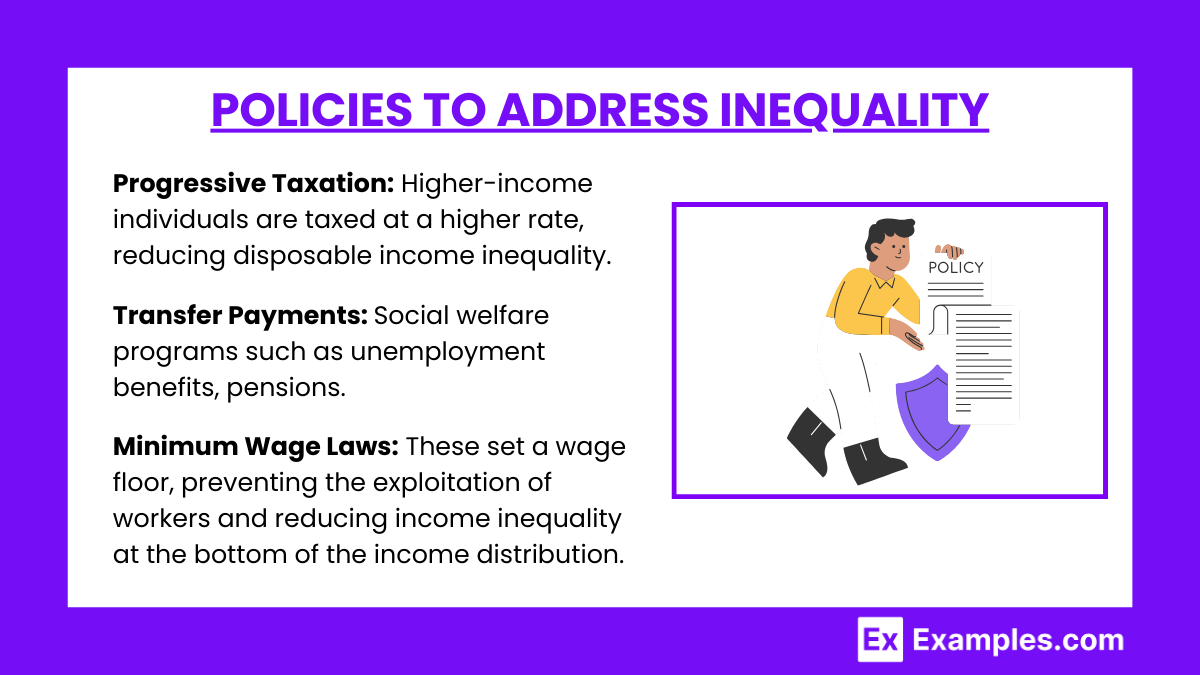
- Progressive Taxation: Higher-income individuals are taxed at a higher rate, reducing disposable income inequality.
- Transfer Payments: Social welfare programs such as unemployment benefits, pensions, and food assistance help redistribute wealth to lower-income households.
- Minimum Wage Laws: These set a wage floor, preventing the exploitation of workers and reducing income inequality at the bottom of the income distribution.
Examples
Example 1: Educational Disparities
In many countries, access to quality education is uneven, contributing to income inequality. Individuals from wealthier families can afford better schools, private tutoring, and higher education, which increase their skills and earning potential. In contrast, those from lower-income households may have limited access to these resources, resulting in lower-paying jobs and fewer opportunities for upward mobility. This gap in educational access perpetuates the cycle of inequality across generations.
Example 2: Gender Pay Gap
Women often earn less than men for performing similar work, even after controlling for factors like education, experience, and job type. This pay disparity, commonly referred to as the gender pay gap, reflects systemic biases and discrimination in the labor market. Women may also face barriers such as limited career advancement opportunities or underrepresentation in high-paying industries, exacerbating both income and wealth inequality over time.
Example 3: Technological Change and Automation
As technology advances, certain industries and workers benefit more than others. Skilled workers, especially those in technology-related fields, may see higher wages as demand for their expertise grows. However, low-skilled workers in industries susceptible to automation, such as manufacturing or retail, may face job losses or wage stagnation. This divide between those who can adapt to new technology and those who cannot widens income inequality within the labor market.
Example 4: Wealth Concentration Among the Top 1%
A significant portion of global wealth is concentrated in the hands of the top 1% of earners, contributing to wealth inequality. These individuals often derive income from capital gains, investments, and inheritance, which grow exponentially over time. In contrast, lower- and middle-income individuals rely primarily on wages, which typically grow at a slower rate. This concentration of wealth among a small elite creates a substantial gap between the rich and the rest of society, making it difficult for others to accumulate wealth.
Example 5: Racial and Ethnic Inequality
Racial and ethnic minorities often face income disparities due to systemic discrimination in hiring, wage setting, and promotions. For example, in the United States, African Americans and Hispanics earn lower wages than their white counterparts for similar levels of education and experience. Wealth inequality is also stark, with minorities less likely to own homes or have access to high-paying jobs. These disparities result in significant gaps in both income and wealth between racial and ethnic groups, often perpetuated across generations.
MCQs
Question 1
Which of the following is the best explanation for why income inequality tends to increase with globalization?
A) Workers in low-skill industries experience wage increases.
B) International trade benefits all workers equally.
C) High-skilled workers benefit more from technological advancements.
D) Government policies always reduce income inequality.
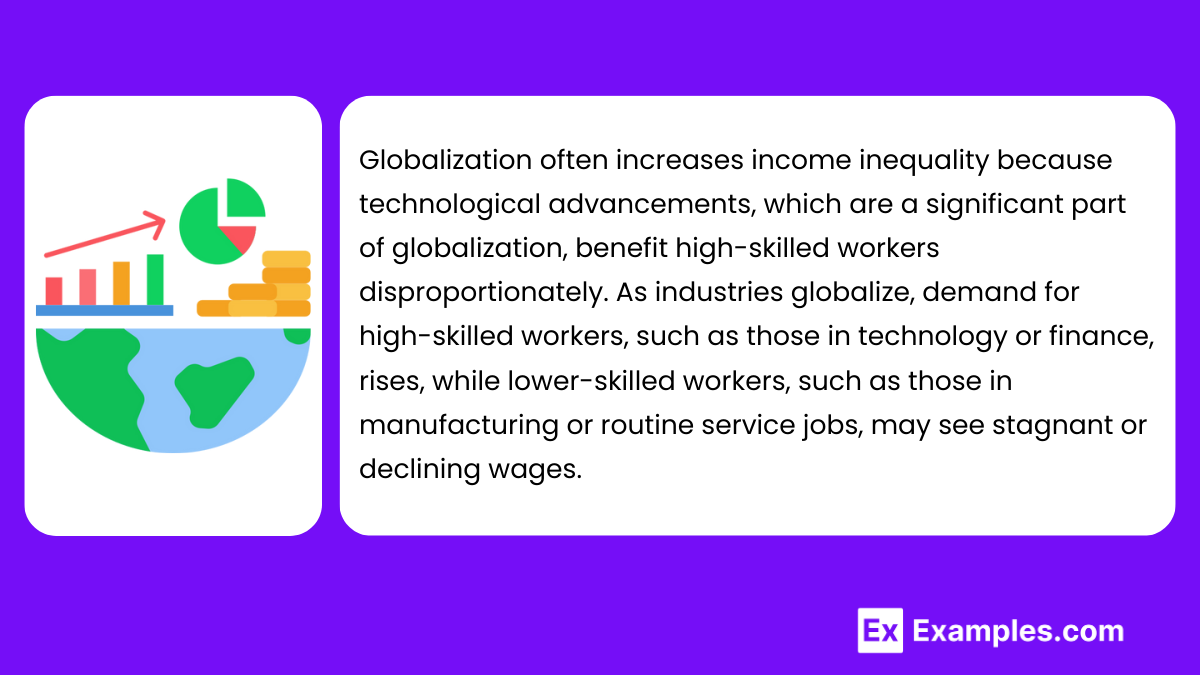
Answer: C) High-skilled workers benefit more from technological advancements.
Explanation:
Globalization often increases income inequality because technological advancements, which are a significant part of globalization, benefit high-skilled workers disproportionately. As industries globalize, demand for high-skilled workers, such as those in technology or finance, rises, while lower-skilled workers, such as those in manufacturing or routine service jobs, may see stagnant or declining wages. This creates a wage gap between high- and low-skilled workers, contributing to income inequality. Options A and B are incorrect because not all workers benefit equally, and low-skill workers may face job losses. Option D is incorrect because government policies do not always reduce inequality.
Question 2
What does the Gini coefficient measure in the context of income and wealth inequality?
A) The level of taxation in an economy.
B) The difference between wages of men and women.
C) The distribution of income or wealth within a population.
D) The number of people living in poverty.
Answer: C) The distribution of income or wealth within a population.
Explanation:
The Gini coefficient is a widely used measure of income or wealth inequality within a population. It ranges from 0 (perfect equality, where everyone has the same income) to 1 (maximum inequality, where one person holds all the income or wealth). This measure helps economists assess the degree of inequality in a society. Option A refers to taxation, which is unrelated to the Gini coefficient. Option B refers to the gender pay gap, and Option D refers to poverty levels, neither of which are measured by the Gini coefficient.
Question 3
Which of the following policies is most likely to reduce income inequality?
A) Regressive taxation that taxes lower-income individuals at a higher rate.
B) Eliminating the minimum wage to increase labor market flexibility.
C) Progressive taxation that taxes higher-income individuals at a higher rate.
D) Providing subsidies to corporations to encourage economic growth.
Answer: C) Progressive taxation that taxes higher-income individuals at a higher rate.
Explanation:
Progressive taxation, where higher-income individuals are taxed at a higher rate, is designed to reduce income inequality by redistributing income from the wealthy to lower-income individuals. This system ensures that those who earn more contribute a larger portion of their income in taxes, which can fund social welfare programs and public services that benefit lower-income groups. Option A (regressive taxation) would actually increase inequality by placing a larger burden on lower-income individuals. Option B (eliminating the minimum wage) could reduce wages for low-skilled workers, worsening inequality. Option D (subsidies to corporations) may boost economic growth but doesn’t directly address income inequality.

